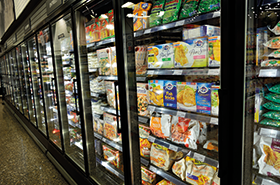

With climate change and the pressure for lower environmental impact, supermarkets are rapidly investing in green energy transition. The new trend for fulfilling heating demand in supermarkets is to use the waste heat from their own cooling display cases. By installing Danfoss heat recovery units, supermarkets could halve their CO2 footprints in five years. Imagine if this was done in all supermarkets around the world.
Re-using excess heat
Keeping food fresh forces electricity meters to run fast in a supermarket. Currently, up to 40% of the electricity consumption in any given supermarket is used for cooling. However, Danfoss has cracked the code to considerable energy savings by re-using excess heat that would otherwise be wasted.
Excess heat from the cooling display cases and freezers is harvested and heats up the store on cold days, as well as making domestic hot water. Furthermore, the supermarket’s surplus heat could be sent out to warm up office space, warehouses, etc. This alternative heating solution from Danfoss ensures efficient recovery of the heat from refrigeration systems, meaning there is hardly any wasted heat as up to 95% can be recycled. This energy transition methodology has already found great success in harvesting savings in supermarkets around the world.
Some stores have shown savings of around 70% on heating costs and about 40% on electricity. Not only has this Danfoss Climate Solutions technology shown a reduction in energy costs, but also a reduction in carbon footprint by approximately half, covering electricity, water and heating.
Supermarkets around the world are converting
Each year, 100 000 supermarkets are installed or retrofitted all over the world. There are huge benefits in terms of savings potential and reduced carbon footprint. The bigger the store, the shorter the payback time with an average of only two years – it’s the cheapest heat any store can get.
Vapour compression systems contain a wealth of opportunities which are among the cheapest and easiest to implement into an emerging smart, flexible energy system. The broader vision for Danfoss is to always have heat recovery on CO2 refrigeration units, which are already widespread throughout the world. Danfoss has new initiatives in the pipeline, including solutions for locations without a district heating grid. The Danfoss heat recovery solution is a complete unit and is one of many innovations created, with more yet to come.
Utilisation of excess heat from CO2 refrigeration plants
The unit prioritises heating of a supermarket’s own plant before any sales to e.g. district heating suppliers. In order to balance different useage patterns (temperatures and heating requirements) on the heating side with the production of excess heat on the cooling side, the unit has been designed as a buffer charging circuit. This results in very stable and uniform charging, also ensuring a long service life for the CO2 heat exchanger. The flow temperature from the heating reticulation unit (HRU) is controlled by the building requirements (heating, hot water or ventilation), either via signals from other equipment or via Modbus from an existing scada system. In the event of possible sale of excess heat to the district heating supplier or other buyers, this can be managed in such a way that a constant temperature is supplied to these buyers. The HRU can send a reference signal to the cooling plant indicating how much heat can be accumulated. A safety function has been embedded to protect against boiling over on the water side.

© Technews Publishing (Pty) Ltd | All Rights Reserved